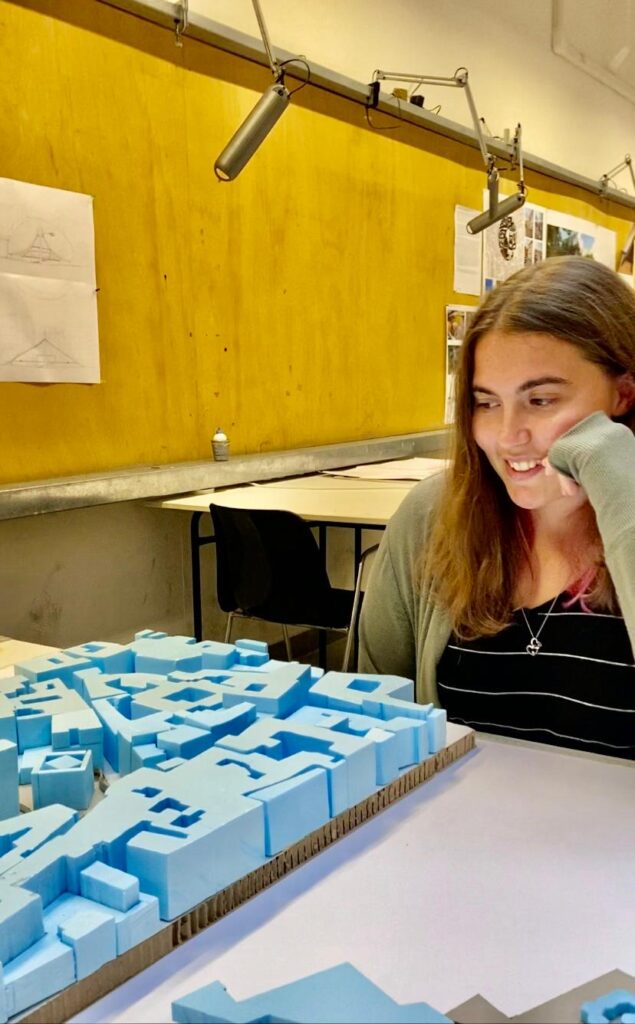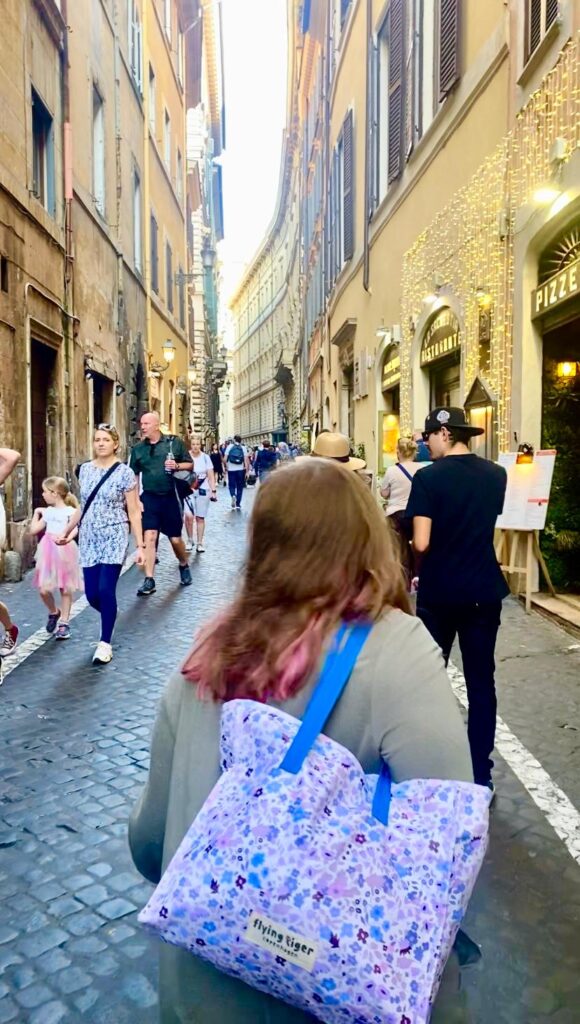
Arianna Davis, Penn State University
“This experiential learning concept, it leaves a stronger impact on the material that you’re learning, it reinforces what you’re learning in the classroom“.
Meet Arianna Davis, a 4th-year undergraduate architecture student from Penn State University, studying at the Pantheon Institute for the Fall 2024 semester. Arianna sat down in the Pantheon Institute Gatta Studio to discuss her passion to pursue architectural studies and how her study abroad experience in Rome has evolved her understanding of physical spaces and their transformative impact on how we perceive the world.
Originally from York, Pennsylvania, just on the border with Maryland, Arianna grew up in a household of engineers. However, it was her grandmother, an architect, that inspired her to consider architecture as a possible career path. Arianna is drawn to architectural studies due to its creative potential and how it has the power to alter people’s reality and their experience in the world. “I am studying architecture because I’ve always loved art. I’ve loved drawing. And in this way, I can create something meaningful that could have a lasting impact on people. We know from experience that everyday spaces have an impact on how you are how you feel. … I want to be a Disney Imagineer and I want to create magical moments and immersive experiences for people because that has always impacted me”.
An important part of Pantheon Institute is its focus on experiential learning and getting students out of the classroom to engage with the city itself and use the local environment as a teaching tool. “This experiential learning concept, it leaves a stronger impact on the material that you’re learning, it reinforces what you’re learning in the classroom. For my Analysis class, and my Cartography class, we’re mostly out on sites. … For Cartography, we walk and talk and see how the public spaces like the piazzas and palazzos impact the surrounding environment and the experience that we have as people and how the buildings create this experience and environment that we’re in.” Winding through the ancient streets of Rome, students are guided to explore the incremental growth and interweaving of time periods visible in the architecture. “Our Analysis class studies how the urban fabric has evolved over time and we analyze how buildings’ features are created together.”

Arianna looking at a model for her studio project, a temporary pavilion for the 2025 Jubilee.
“And then when I got here [to Rome] and I was experiencing Baroque architecture and all these different ornamentation styles, like the Papacy symbols, it has another meaning when you’re experiencing it in person versus just studying it”.

Learning about the Noli Map with Cartography Professor Cothran Ceen.

On a walk through Rome with Cartography Professor Cothran Ceen.
Arianna explains that, before coming to Rome, “I didn’t understand all the ornamentation to buildings before when I was studying them, because I just didn’t understand the point of it. And then when I got here [to Rome] and I was experiencing Baroque architecture and all these different ornamentation styles, like the papacy symbols, it has another meaning. When you’re experiencing it in person versus just studying it. And now I love Baroque architecture. It’s so pretty. The movement, the dynamicism, the style in general, it’s a different feeling when you’re here experiencing it”.

Walking down Via del Seminario while on route to the Gatta Studio.
Reflecting on the location of the Pantheon Institute and it’s place in the Eternal City, Arianna explains, “Pantheon Institute is in an area with really cool nightlife and so many good restaurants and tiny stores, but also, it’s in a location within a walkable distance to a lot of the more popular sites.” The studios and classrooms are only a 20-minute walk from the dormitory, but that time to navigate the city allows students to feel “integrated” with the local community.
For future students, Arianna recommends approaching your study abroad in Rome with curiosity and a sense of exploration. “Just go out and find something. You’ll find something really cool. For example, for my Analysis project … I was just wandering around and I just stumbled upon this beautiful fountain that I wasn’t technically ever planning on using. Just let your curiosity [lead you]. Be okay with not having a plan”. Investigating with an open mind is a great way to discover new things and challenge previous preconceptions, all by taking the opportunity to look at something from a new perspective.
“Make your semester in Rome memorable and don’t just stress from school. Remind yourself that it’ll go by fast”.
When asked what her biggest piece of advice would be to future students, Arianna says, “Just enjoy it. I don’t know how we’re at the end of October. … You kind of lose track of the fact that you’re studying abroad in Rome, so, just remember, this is only a semester, so, enjoy it. Your class deadline will pass. Make your semester in Rome memorable and don’t just stress from school. Remind yourself that it’ll go by fast”.


